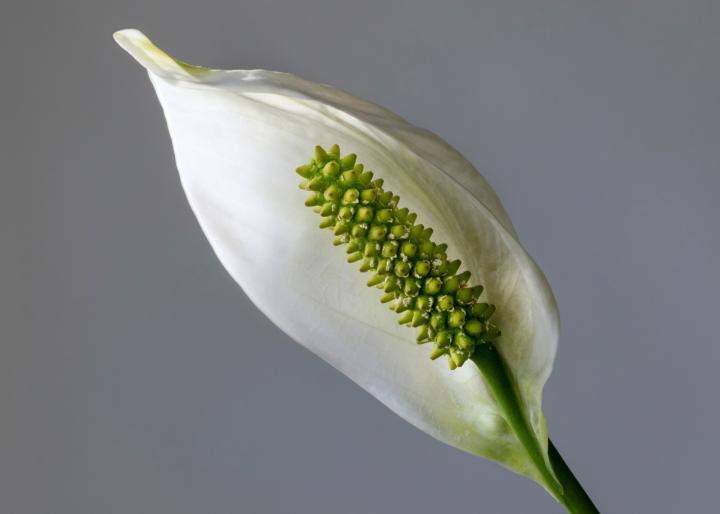Why is my peace lily leaves turning brown?
| Common Name | Peace lily, spath lily |
| Botanical Name | Spathiphyllum spp. |
| Family | Araceae |
| Plant Type | Perennial |
| Mature Size | 1–4 ft. tall, 1–4 ft. wide (indoors), up to 6 ft. tall (outdoors) |
| Sun Exposure | Partial |
| Soil Type | Moist but well-drained |
| Soil pH | Acidic |
| Bloom Time | Spring |
| Flower Color | White, yellow |
| Hardiness Zones | 11–12 (USDA) |
| Native Area | Central America, Asia |
| Toxicity | Toxic to pets3 and people4 |
Peace lilies’ brown leaves can be attributed to temperature fluctuations, sunburn, and dry soil from underwatering, while their leaf tips turn brown due to low humidity, which saps too much moisture from the leaves.
The most common reasons for peace lily leaves turning brown include various factors.
- Low humidity turns the leaf tips brown. Peace lilies are tropical plants that prefer a humid environment. Low humidity from indoor heating or air conditioning, saps moisture from the leaves, turning the leaves and leaf tips brown.
- Underwatering cause yellow and brown drooping leaves. Peace lilies need evenly moist soil. if the soil is too dry the leaves turn brown.
- Too much fertilizer causes leaf tips to turn brown. Peace lilies are more sensitive to fertilizer then most house plants. If fertilizer is applied too often or in too high concentration, the leaf tips turn brown.
- Hard tap water with too many minerals or chemicals (fluoride and chlorine) can cause brown tips. Peace lilies prefer to be watered with rain water, bottled water or distilled water to avoid brown tips.
- Overwatering and poor drainage. Peace lilies need potting soil to be evenly moist, yet well draining. Boggy soil initially causes the leaf tips to turn brown and eventually results in yellowing, drooping leaves.
- Direct sunlight scorches leaves yellow and brown. Peace lilies are adapted to grow in the shade, so if the leaves are in the sun burn to a yellow and brown color.
- Fluctuating temperatures cause leaves to turn brown. Peace lilies prefer a temper range of 68°F and 85°F with around 10°F cooler at night. If the temperature is too hot, then this can dry the soil too quickly causing drooping and brown or yellow leaves, whereas cold stress can also cause brown, dying leaves.
With all these interpretations, the peace lily has many incredible benefits!
To revive a brown peace lily, increase humidity by misting its leaves, plant it in well-draining soil, water it every 7 days, place it in shade, and use sharp pruners to cut back any brown leaves or leaf tips.
Peace Lily Leaves and Leaf Tips Turning Brown
To revive a brown peace lily, increase humidity by misting its leaves, plant it in well-draining soil, water it every 7 days, place it in shade, and use sharp pruners to cut back any brown leaves or leaf tips.
Peace lilies (Spathiphyllum wallisii) require regular watering to maintain an even soil moisture level.
Soil drying out can cause it to become hydrophobic, preventing water from infiltrating the soil and reaching the roots. This can result in water running off the surface, down the side of the pot, and out of the drainage hole.
If the peace lily’s roots are unable to obtain the necessary water, it may display signs of stress through drooping leaves with brown tips.
Peace lilies are tropical plants native to central and South America, found in humid forests in their native environment.
Indoor humidity is typically lower than peace lilies prefer, which can cause brown leaf tips. This can be worsened by indoor heating, air conditioning, and open door drafts. Dry air saps moisture from leaves, turning tips brown as a sign of stress. Peace lilies are sensitive to direct sunlight and bright light, which can cause brown tips. Direct sunlight scorches leaves and flowers, while dry conditions are the most common cause. Other factors can also contribute to brown leaves.
- Overwatering and poor drainage
- Too much fertilizer or not enough fertilizer,
- Hard tap water (too many minerals) or chemicals in tap water such as fluoride and chlorine can also be responsible for peace lily leaf tips turning brown.
How to Save a Peace Lily With Brown Leaves and Brown Leaf Tips

- Place the peace lily in a basin of water for 10 minutes or more, ensuring the root ball is fully submerged. This ensures that water can absorb in the soil properly, so that the roots can access the moisture they need rather then water trickling of the surface.
- Water peace lilies with a really thorough soak every 7-10 days. The peace lily prefers a cycle of watering where the soil is watered thoroughly then the surface of the soil is allowed to dry between bouts of watering. This ensures that the peace lily has access to enough moisture to meet its water requirements without risking root rot from boggy soil.
- Mist the leaves too increase the humidity indoors. Either mist the leaves of use a special plant humidifier to increase the humidity around your peace lily. Misting the leaves creates a humid micro-climate around the peace lilies leaves which emulates the humid conditions of its native environment and counteracts the affects of dry air indoors, to prevent brown leaf tips.
- Avoid locating peace lilies near a source of heat or in the path of air currents from air conditioning or draughts. Peace lilies grow well at room temperature, but indoor can dry the air significantly, so ideally place your peace lily away from any indoor heating.
- Reduce how often you water the peace lily. Peace lilies prefer a good soak, so that the soil is evenly moist, then wait for the surface of the soil to dry before watering again. This mimics the typical conditions of soil moisture in the peace lilies natural habitat. Typically this means watering peace lilies every 7- 10 days.
- Ensure the peace lily is planted in a pot with drainage holes in the base to allow water to drain freely. Peace lilies need evenly moist that drains well, to avoid excess water pooling around the roots. Empty any saucers or trays underneath the pot of excess water regularly to ensure good drainage.
To water your peace lily in hard water, use rainwater, bottled water, or filtered water to avoid browning the leaf tips. Additionally, leave the water in a bowl overnight to evaporate fluoride and chlorine, making it safe to water the peace lily.
Should I cut the brown tips off my peace lily leaves?
To restore the peace lily’s leaf appearance and stimulate new growth, trim brown leaf tips back with a natural, rounded shape using sharp pruners. This method does not harm the peace lily and, once the brown leaf tips are fixed, the peace lily should remain a healthy green.

Peace Lily Leaves Turning Brown and Yellow
How to Fix a Peace Lily with Brown and Yellow Leaves
- Move the peace lily to an area of shade with indirect light. Peace lilies tolerate shade to bright indirect light, so find any location where the peace is out of the sun.
- Give the peace lily a thorough watering and mist the leaves. If the leaves have been scorched in the sun then it has probably also caused drought stress, so misting the leaves and giving the soil a good soak to ensure the roots can access moisture should help if the leaves are drooping.
The peace lily’s leaves should not turn green again if they have scorched brown and yellow, but they should not be cut back during stress.
To ensure peace lilies thrive, provide them with optimal conditions like high humidity, room temperature, and evenly moist soil. Wait for new green growth and prune only up to 1/3 of the leaves, even if scorched. Trim dying leaves back to the plant’s base to improve appearance and stimulate healthy growth. Peace lilies can recover quickly when in active growth.
Peace Lily Leaves Turning Brown and Dying Due to Fluctuating Temperatures
Peace lilies often turn brown and die due to temperature fluctuations. They prefer a temperature range of 68°F to 85°F, with temperatures around 10°F cooler at night. If the temperature exceeds this range or changes suddenly, the leaves turn brown. Peace lilies typically grow well at room temperature, but if they are on a window sill and in contact with the widow, cold glass at night can turn the leaves or flowers brown.
Furthermore, indoor temperatures in winter can cause the leaves to turn brown. The temperature cycle in winter is opposite to the peace lily’s native environment, and heating in the evening can suddenly increase the temperature at a time when the peace lily prefers cooler temperatures. Additionally, indoor heating can lower humidity and increase soil drier rate, which can be unfavorable for the peace lily and contribute to the leaves turning brown.
How to Save a Peace Lily with Brown, Dying Leaves
- Locate the peace lily on the other side of the room from indoor heating. As long as the peace lily is not directly in the path of a forced air current or next to a radiator, then the peace lily should be able to recover. High temperatures at night, (when the peace lily prefers cooler temperatures) should be avoided, however possible.
- Avoid placing the peace lily too near a window, where the leaves or flowers can be in contact with the cold glass. Windows feel much colder then the rest of the room and can cause localized brown areas on the peace lily leaves if they are touching the glass.
- Avoid draughty areas such as near open doors or windows as a blast of cool air can harm the peace lily.
- Mist the leaves to counteract dry air and submerge the root ball in a basin of water. The misting of the leaves (you can also use a humidifier) should help to alleviate the drought stress and replicate natural tropical, humid conditions. High temperatures cause the potting soil to bake hard, so submerging the root ball in a basin of water for 10 minutes is the best way to ensure the water reaches the roots properly.
Peace lilies thrive in temperatures between 68°F and 85°F, with a nighttime temperature around 10°F cooler. Avoid placing them near indoor heating or sudden cold to ensure their recovery.
Should I cut the brown leaves off my peace lily?
To maintain the peace lily, use sharp pruners to cut back brown, dying leaves to the base of the plant. This stimulates the growth of new green leaves and restores the plant’s appearance. It’s best to prune peace lilies during active growth in the Spring and Summer, as the plant is more resilient. If leaves turn brown, droop, or die, they can be cut back anytime. Avoid using fertilizer, as it can place too much stress on the peace lily’s resources. Use fertilizer only during active growth in the Spring and Summer.
Key Takeaways:
Peace lily leaves turn brown due to various factors, including drought, low humidity, temperature fluctuations, sun burn, and dry soil. They are sensitive to sunlight, causing them to scorch yellow and brown. The leaves can also turn drooping and dying due to sudden temperature fluctuations, which can cause a drooping, dying appearance. To restore the peace lily’s appearance, cut back brown leaf tips and mist them to prevent them from turning brown again. To revive a peace lily with brown leaves, mist the leaves to increase humidity, water the soil thoroughly, and protect the leaves from direct sunlight. Finally, prune the brown leaves back to the base to stimulate healthy growth. Peace lilies are adapted to growing in the shade and prefer a temperature range of 68°F to 85°F, with around 10°F cooler at night.











